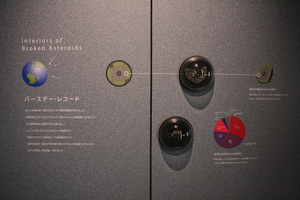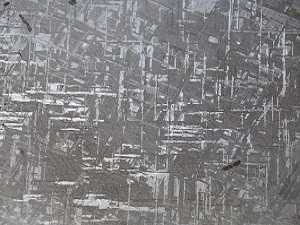Nagoya City Science Museum
TOP > Exhibition Guide > Keyword Search > Starting with "M" > meteorite > Geosphere -Interiors of Broken Asteroids-
Geosphere -Interiors of Broken Asteroids-



Purpose of Exhibition
What makes the earth's interior? What "materials" make the earth? A hint is "meteorite". Let's imagine the magnificent drama of the birth of the earth by seeing an actual meteorite.
Additional Knowledge
[The Materials of the Earth]
Subsurface material is divided between the heavy substances in the lower position and the light substances in the upper position (Differentiated). What was the subsurface material before the differentiation? How was it differentiated? The hint to know is in the "meteorite" that fell from outer space.
[Chondrite]
About 86% of a meteorite is "chondrite" which contains round grains called chondrule. Chondrule was droplets of molten mineral and metal, and both heavy and light substances are blended. So, it is thought that chondrule was made in a non-gravitational environment with high temperatures. The chemical composition of chondrite is similar to the sun (except for the volatile elements such as hydrogen and helium). The formation age is about 4.56 billion years ago and is older than the oldest rock on earth. It is thought chondrule is non-differentiated material that had recorded the state of the solar system when it was born.
The exhibition "Allende Meteorite" is carbonaceous chondrite which had fallen in Mexico in 1969.
[Iron Meteorite]
Iron meteorite is an alloy (nickel-iron) of iron and nickel. It has 90 percent iron, several percent nickel and a small amount of cobalt.
When the cut surface of the iron meteorite is processed by acid, we can see the geometric patterns in which metallic crystal is entangled. This is called "Widmanst_tten pattern". It is required to be cooled down very slowly by just a few degrees over a million years so that the metallic crystal can become so big. Therefore, it is said that a big celestial body has enough gravity to separate light substances into the upper part and heavy ones in the lower. After that, the celestial body burst and the alloy core flew to the earth.
The meteorite which is exhibited is the Gibeon meteorite that was discovered in the Republic of Namibia in 1836. It is said the gross weight of the meteorites which were collected was over 10 ton.
[Stony-iron Meteorite]
Stony-iron meteorite is a meteorite like the iron meteorites, which contains a blend of silicate minerals. We call it a "parasite" which contains olivine as a mineral. The stony-iron meteorite which has separated the heavy substances in the lower part and the light substances in the upper part might have been the center of an asteroid which did not have enough gravity to separate completely, or the boundary line of the core of a protoplanet, in which iron meteorites was made within the mantle. The exhibition "Imilac meteorite" was discovered in the Atacama Desert, Chile in 1822.
[Guessing the Interior Earth from Meteorites]
It is thought that most meteorites have been come from the asteroid belt. In the asteroid belt, there are asteroids which could not become planets and still remain in the condition of which the solar system was born. It is also thought that chondrite makes the Itokawa asteroid. When an asteroid crashes into other asteroids or has a near-miss and has to modify its orbit, the asteroid falls down to earth. Chondrite (undifferentiated meteorite) is the primordial material of the solar system, and other meteorites are those which melted once and differentiated into a heavy part and a light one. The substance of the earth consists of layered structures by differentiation, made like a meteorite which has differentiated layers. Meteorites are the key to understanding the inner earth.
Article by Shoji Nishimoto, curator
